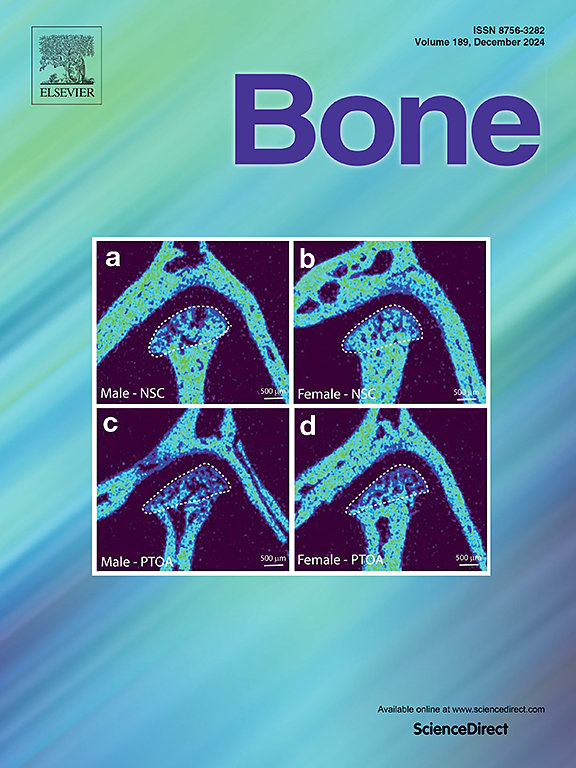Metabolic, skeletal, and cartilage effects of a high-fat diet and the therapeutic impact of MGL3196 are age- and sex-dependent in mice
IF 3.5
2区 医学
Q2 ENDOCRINOLOGY & METABOLISM
引用次数: 0
Abstract
Aged individuals with type 2 diabetes (T2D) may suffer from complications of common comorbid conditions like osteoporosis or osteoarthritis. MGL3196 (MGL) is a therapeutic thyroid hormone receptor beta (TRβ) agonist that has been shown to rescue non-alcoholic steatohepatitis by enhancing lipid metabolism. In a previous study, we demonstrated that MGL treatment protected against high-fat diet (HFD)-induced adiposity but increased HFD-induced trabecular bone loss in male mice. In this study, we explored the impact of MGL treatment on adiposity, bone, and cartilage in aged-21-month-old C57BL/6J mice after a 12-week HFD regimen. Our results show that MGL reduced body weight as well as adverse effects caused by HFD adiposity, in male mice only. Aged HFD-fed male mice experienced cortical bone loss, in contrast to the trabecular bone loss observed in adult male mice. Notably, MGL treatment further exacerbated the cortical bone loss. Mechanical testing of tibias from aged male mice by 3-point bending revealed a reduced maximum load and tibia stiffness with HFD and MGL treatment. Transcriptome analyses for cortical bone formation regulators unveiled a decreased expression of Wnt16 and increased expression of the Wnt inhibitor, Sost, in the bones of HFD-fed male mice. Additionally, measurements of articular cartilage indicated that MGL treatment reduced articular cartilage degradation in both sexes, which was attributed to aging and a HFD. Our findings suggest tailored therapies are necessary to address the adverse effects of a HFD on fat, bone, and cartilage metabolism, specifically considering factors such as age and sex.

在小鼠中,高脂肪饮食对代谢、骨骼和软骨的影响以及MGL3196的治疗作用是年龄和性别依赖的。
老年2型糖尿病(T2D)患者可能患有常见的合并症,如骨质疏松症或骨关节炎。MGL3196 (MGL)是一种治疗性甲状腺激素受体β (TRβ)激动剂,已被证明通过增强脂质代谢来拯救非酒精性脂肪性肝炎。在之前的一项研究中,我们证明了MGL治疗可以防止高脂肪饮食(HFD)诱导的肥胖,但会增加HFD诱导的雄性小鼠小梁骨丢失。在这项研究中,我们探讨了MGL治疗对21月龄C57BL/6 J小鼠在12周HFD治疗后的肥胖、骨骼和软骨的影响。我们的研究结果表明,仅在雄性小鼠中,MGL减轻了体重以及由HFD肥胖引起的不良反应。饲喂hfd的老年雄性小鼠出现皮质骨丢失,与成年雄性小鼠观察到的小梁骨丢失形成对比。值得注意的是,MGL治疗进一步加剧了皮质骨丢失。通过三点弯曲对老年雄性小鼠胫骨的力学测试显示,HFD和MGL处理降低了最大载荷和胫骨刚度。皮质骨形成调节因子的转录组分析显示,在饲喂hfd的雄性小鼠骨骼中,Wnt16的表达减少,Wnt抑制剂Sost的表达增加。此外,关节软骨的测量表明,MGL治疗减少了两性关节软骨退化,这归因于衰老和HFD。我们的研究结果表明,有必要针对HFD对脂肪、骨骼和软骨代谢的不利影响进行量身定制的治疗,特别是考虑年龄和性别等因素。
本文章由计算机程序翻译,如有差异,请以英文原文为准。
求助全文
约1分钟内获得全文
求助全文
来源期刊

Bone
医学-内分泌学与代谢
CiteScore
8.90
自引率
4.90%
发文量
264
审稿时长
30 days
期刊介绍:
BONE is an interdisciplinary forum for the rapid publication of original articles and reviews on basic, translational, and clinical aspects of bone and mineral metabolism. The Journal also encourages submissions related to interactions of bone with other organ systems, including cartilage, endocrine, muscle, fat, neural, vascular, gastrointestinal, hematopoietic, and immune systems. Particular attention is placed on the application of experimental studies to clinical practice.
 求助内容:
求助内容: 应助结果提醒方式:
应助结果提醒方式:


